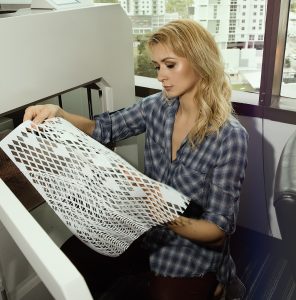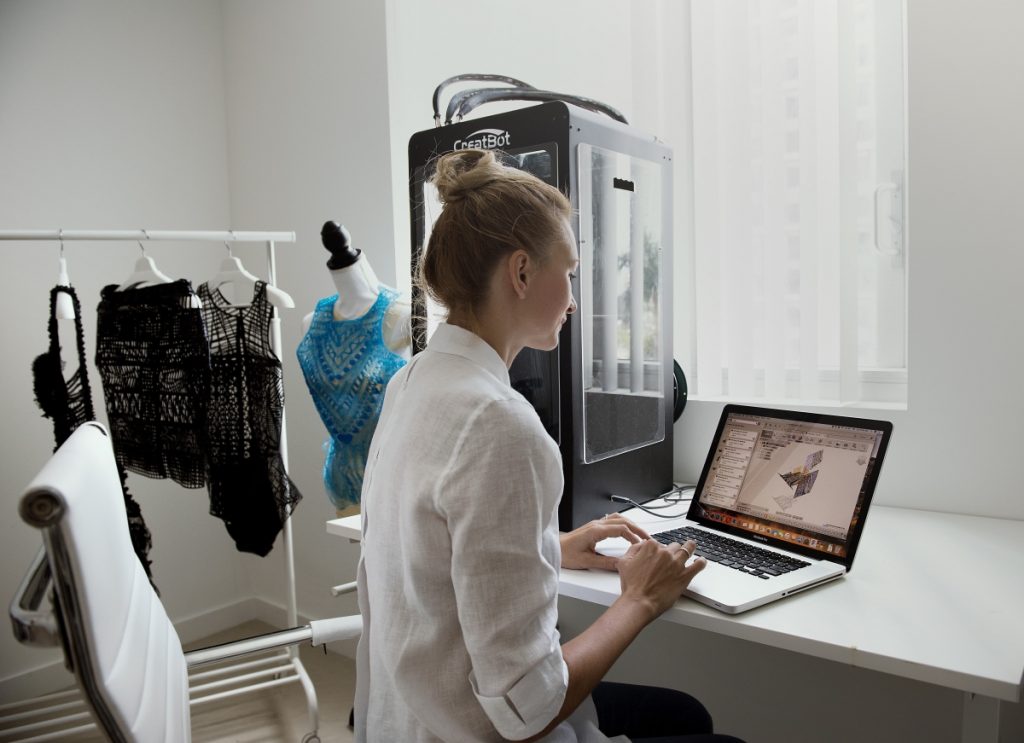 Over these past years, the fashion industry has had a high interest in wearable technology and 3D printing. Thanks to the drop in 3D printer cost and its impact to the manufacturing industry, fashion designers can now use 3D printed designs as another creative tool. Architects and engineers have partnered with fashion designers and created high-end fashion that could change the future of how we dress. These creations go from classic designs to clothing that can interact with your body. It is clear that the role of 3D printing in fashion is evolving continually, providing fashion designers with a canvas for creative expression.
Over these past years, the fashion industry has had a high interest in wearable technology and 3D printing. Thanks to the drop in 3D printer cost and its impact to the manufacturing industry, fashion designers can now use 3D printed designs as another creative tool. Architects and engineers have partnered with fashion designers and created high-end fashion that could change the future of how we dress. These creations go from classic designs to clothing that can interact with your body. It is clear that the role of 3D printing in fashion is evolving continually, providing fashion designers with a canvas for creative expression.
3D printing allows fashion designers to surpass the boundaries of design by turning into reality the most challenging design concepts. What was once traditional pattern-cutting and sewing textiles together it is now a creation of a totally three-dimensional piece. 3D printed materials enable physical properties to be incorporated in specific areas of a textiles, such as flexible, waterproof, rigid or opaque pieces that can be combined into a single garment that can have both a simple or complex geometry and structure. By combining physics and architecture, fashion designers can create exact sizes and curvatures for an accurate fit and personalization.
There are incredible creations from various fashion designers around the world in 3D printing, below we list some of them.
Julia Daviy
 Julia Daviy’s interest in smart clothing began in 2009, leading her to launch a line of organic activewear in 2015. As an ecologist and clean technology industry manager, she realized that production itself was labor-intensive and environmentally irresponsible. In order to look for a solution, Daviy dived into the 3D printing.
Julia Daviy’s interest in smart clothing began in 2009, leading her to launch a line of organic activewear in 2015. As an ecologist and clean technology industry manager, she realized that production itself was labor-intensive and environmentally irresponsible. In order to look for a solution, Daviy dived into the 3D printing.
After passing the 3D printing specialization courses in the University of Illinois at Urbana-Champaign, as well as other courses on 3D modeling and 3D printing, she bought her first 3D printer. As a creator, designer, and 3D printer operator, Daviy sticks to the goal of making the first wearable clothing line created completely by 3D printers. Her pieces include 3D printed dresses and tops that are environmentally friendly since they don’t need to be mass-produced and stocked.
Daviy likes to create her own meshes and fabrics which led her to numerous experiments. Daviy is certain that 3D printing is attainable for fashion because it is biodegradable, faster, cheaper and more sustainable.
Silvia Fado
 Together with Hexxon – a group of engineers specialized in 3D printing – Silvia Fado has developed a prototype for shoes with carbon fiber 3D printed material. This material gives special strength and lightness to the shoes.
Together with Hexxon – a group of engineers specialized in 3D printing – Silvia Fado has developed a prototype for shoes with carbon fiber 3D printed material. This material gives special strength and lightness to the shoes.
Fado has a strong interest in architecture and a background in knitwear design, and she’s focused in new technologies and engineering. After studying traditional techniques for making shoes, she completed a Master in Fashion Footwear at the London College of Fashion, her true passion. Fado’s work is centered in the study of functionality and applications in luxury footwear; the synergy between comfort and aesthetics in a tangible and philosophical way.
Fado’s latest design is called CARBONALISE. The shoes were made for the South 36.32n, a Fashion Festival in Cádiz. CARBONALISE uses the techniques of traditional footwear and new technologies, mixing her methology with 3D printing. Her shoes are available under request on her website.
Ganit Goldstein
 Graduated from the Bezalel Academy of Arts and Design, Ganit Goldstein is a designer who launched a collection called Between the Layers that consists of garments and shoes. Goldstein started said collection as a graduation project, utilizing 3D printed PLA and TPU.
Graduated from the Bezalel Academy of Arts and Design, Ganit Goldstein is a designer who launched a collection called Between the Layers that consists of garments and shoes. Goldstein started said collection as a graduation project, utilizing 3D printed PLA and TPU.
Goldstein is interested in the intersection between craft and technology. She is actively working to incorporate 3D printing and scanning into 3D textiles. As the collection received interest and immediate press recognition, Goldstein’s work was presented at exhibitions and museums around the world.
By mixing tradition and futuristic techniques, Goldstein has created her own special algorithm to create 3D printed lacework designs. She believes that 3D printing gives her full control of any voxel for any pattern, and that it enables her to design without boundaries.
Ica Paru and Kostika Spaho
Ica & Kostika is a fashion start-up that specializes in 3D printed footwear. Their shoes are created with passion by combining art and mathematics. One of their designs, The Mycelium Shoe, looks like a true work of art.
To acquire one of these shoes, the users have to download an app where they upload photos of their feet. Ica & Kostika’s algorithm creates a 3D sketch of the users’ feet for better fit before 3D printing the shoes.
The users get a personalized and wearable shoe with a unique silhouette and fit. The Mycelium Shoes are part of their newest collection: Exobiology. Each shoe looks like a whole new sculpture inspired from nature.
Rosanne van der Meer and Annelie Ansingh
 Rosanne van der Meer and Annelie Ansingh met at a fashion academy where they became friends and shared their passion. Today, they have a startup called The Girl and the Machine.
Rosanne van der Meer and Annelie Ansingh met at a fashion academy where they became friends and shared their passion. Today, they have a startup called The Girl and the Machine.
These startup designers are certain that we all have a unique genetic code that makes us who we are. Their goal is to write a code for creating unique clothes for every individual. For Rosanne and Annelie, their designs are easy to change and made to measure to fit the customer’s needs.
Rosanne and Annelie use a 3D knitting technique that creates clothing using a unique code for every design. Their clothing fits each customer, thus, there is no two pieces alike. They believe that involving the customer directly in the design process and creating clothing that fits them, can eliminate some of the vast amounts of clothing waste that is discarded.
Fashion designers have demonstrated that there is no limit for creating patterns and thus, creating new and innovative designs. 3D printing gives them the complete freedom and technology to create the revolutionary wear of the future, as well as changing the way clothes are produced. Maybe one day 3D printing will replace traditional textiles.
[Sources/Images: WhichPLM, The Girl and the Machine, Silvia Fado, Ganit Goldstein, Ica & Kostika, Julia Daviy]Subscribe to Our Email Newsletter
Stay up-to-date on all the latest news from the 3D printing industry and receive information and offers from third party vendors.
You May Also Like
3D Printing Unpeeled: New Arkema Material for HP, Saddle and Macro MEMS
A new Arkema material for MJF is said to reduce costs per part by up to 25% and have an 85% reusability ratio. HP 3D HR PA 12 S has been...
3D Printing News Briefs, January 20, 2024: FDM, LPBF, Underwater 3D Printer, Racing, & More
We’re starting off with a process certification in today’s 3D Printing News Briefs, and then moving on to research about solute trapping, laser powder bed fusion, and then moving on...
3D Printing Webinar and Event Roundup: December 3, 2023
We’ve got plenty of events and webinars coming up for you this week! Quickparts is having a Manufacturing Roadshow, America Makes is holding a Member Town Hall, Stratafest makes two...
Formnext 2023 Day Three: Slam Dunk
I’m high—high on trade show. I’ve met numerous new faces and reconnected with old friends, creating an absolutely wonderful atmosphere. The excitement is palpable over several emerging developments. The high...











































